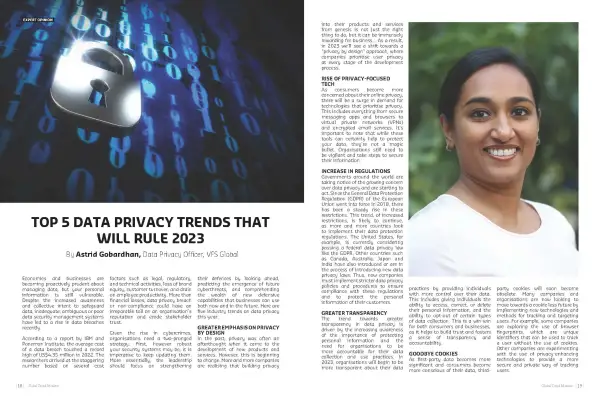By Astrid Gobardhan, Data Privacy Officer, VFS Global
Economies and businesses are becoming proactively prudent about managing data, but your personal information is still vulnerable. Despite the increased awareness and collective intent to safeguard data, inadequate, ambiguous or poor data security management systems have led to a rise in data breaches recently.
According to a report by IBM and Ponemon Institute, the average cost of a data breach touched a record high of US$4.35 million in 2022. The researchers arrived at the staggering number based on several cost factors such as legal, regulatory, and technical activities, loss of brand equity, customer turnover, and drain on employee productivity. More than financial losses, data privacy breach or non-compliance could have an irreparable toll on an organisation’s reputation and erode stakeholder trust.
Given the rise in cybercrimes, organisations need a two-pronged strategy. First, however robust your security systems may be, it is imperative to keep updating them. More essentially, the leadership should focus on strengthening their defences by looking ahead, predicting the emergence of future cyberthreats, and comprehending the wealth of new defensive capabilities that businesses can use both now and in the future. Here are five industry trends on data privacy this year:
- Greater emphasis on privacy by design: In the past, privacy was often an afterthought when it came to the development of new products and services. However, this is beginning to change. More and more companies are realising that building privacy into their products and services from genesis is not just the right thing to do, but it can be immensely rewarding for business. . As a result, in 2023 we’ll see a shift towards a “privacy by design” approach, where companies prioritise user privacy at every stage of the development process.
- Rise of privacy-focused tech: As consumers become more concerned about their online privacy, there will be a surge in demand for technologies that prioritise privacy. This includes everything from secure messaging apps and browsers to virtual private networks (VPNs) and encrypted email services. It’s important to note that while these tools can certainly help to protect your data, they’re not a magic bullet. Organisations still need to be vigilant and take steps to secure their information.
- Increase in regulations: Governments around the world are taking notice of the growing concern over data privacy and are starting to act. Since the General Data Protection Regulation (GDPR) of the European Union went into force in 2018, there has been a steady rise in these restrictions. This trend, of increased restrictions, is likely to continue, as more and more countries look to implement their data protection regulations. The United States, for example, is currently considering passing a federal data privacy law like the GDPR. Other countries such as Canada, Australia, Japan and India have also introduced or are in the process of introducing new data privacy laws. Thus, now companies must implement stricter data privacy policies and procedures to ensure compliance with these regulations and to protect the personal information of their customers.
- Greater transparency:
The trend towards greater transparency in data privacy is driven by the increasing awareness of the importance of protecting personal information and the need for organisations to be more accountable for their data collection and use practices. In 2023, organisations will begin to be more transparent about their data practices by providing individuals with more control over their data. This includes giving individuals the ability to access, correct, or delete their personal information, and the ability to opt-out of certain types of data collection. This is a win-win for both consumers and businesses, as it helps to build trust and fosters a sense of transparency and accountability.
- Goodbye Cookies
As first-party data becomes more significant and consumers become more conscious of their data, third-party cookies will soon become obsolete. Many companies and organisations are now looking to move towards a cookie less future by implementing new technologies and methods for tracking and targeting users. For example, some companies are exploring the use of browser fingerprints, which are unique identifiers that can be used to track a user without the use of cookies. Other companies are experimenting with the use of privacy-enhancing technologies to provide a more secure and private way of tracking users.
